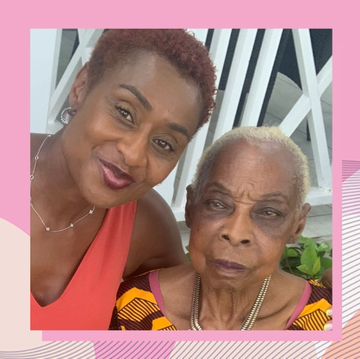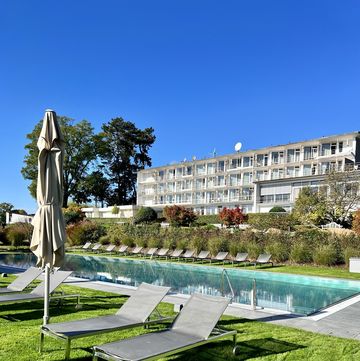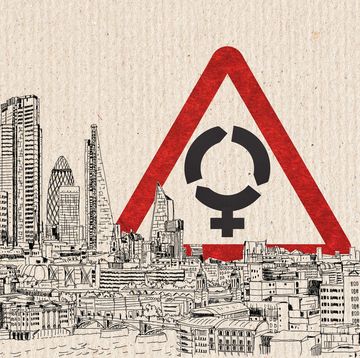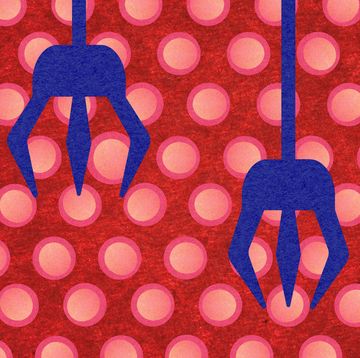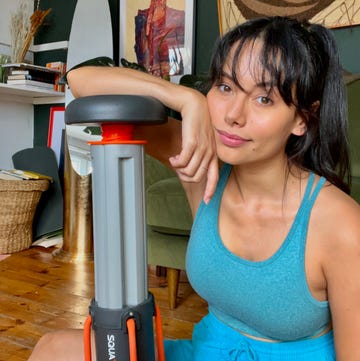When I was diagnosed with breast cancer aged 40, it was like a big red stop sign flashed up in front of my face, obscuring everything in my peripheral vision. I’d been living an always-on lifestyle that saw me dashing from nursery drop-off to the school run (my kids were three and six at the time), to my busy job as deputy editor on a magazine, to Pilates classes, family commitments and social events - with little time to draw breath in between.
Going from that to lying in bed after chemotherapy, watching one episode of Emily in Paris merge into another, felt deflating at best, depressing at worst. But the only advice I’d received from my medical team had been to ‘rest’, so that’s what I did.
Of course, rest is important. Depending on what treatments you have, your body is likely to have experienced significant trauma. It needs time to heal, and so you need to prioritise what so many of us overlook in our hurried, modern lives: good quality sleep, nutrient-rich whole foods and proper, time-off rest. But, it turns out, not at the expense of any kind of movement.
Many people’s experience of cancer treatment could be transformed, with the right support, by simply incorporating a little bit of movement into their lives. Research published in the journal Scientific Reports last year showed that exercise improved the physical and mental side effects of chemotherapy and radiotherapy (notably fatigue), and sped up post-surgical recovery, with fewer complications.
Not only that, some of the latest evidence from California found that exercise reduces your risk of cancer recurrence by at least 40%, and up to 60%. Movement is particularly potent for breast cancer survivors in particular. One 2021 study even found that the risk of recurrence was 63% lower in breast cancer survivors who exercised on 2–5 days of the week compared with inactive participants.
If you’ve been through treatment, the chances are you would do anything to avoid having to go through that again, so let me say it louder for those at the back: exercise reduces the risk of breast cancer recurrence by around half.
‘Ten years ago, ‘rest is best’ was the prescription,’ explains Sarah Newman, a cancer and exercise specialist and founder of cancer rehab programme getmeback.uk. ‘But we now know from the research that movement helps patients recover faster, manage side effects and even make their treatment work more effectively. Patients should now be encouraged to stay as active as possible.’
FIGHTING FIT
Of course, if you’re undergoing treatment for cancer, the thought of exercise can be overwhelming. Believe me, I understand. My treatment involved five months of intense chemotherapy, leaving me physically and emotionally broken. Then mastectomy surgery, which involved taking flesh from my abdomen to reconstruct my right breast.
The ten-hour operation also removed all of the lymph nodes from under my right arm. After surgery, I went straight into radiotherapy: yet another assault on my recovering body. And since my cancer was a particularly aggressive type, I then had six more months of chemo to reduce my risk of recurrence.
During this time, my capacity for movement was limited – there were times when I could barely walk around the block. My first hobble outside after surgery felt like an achievement akin to running a marathon.
But now, having seen the evidence, I do wish somebody had explained to me how beneficial it would be to prioritise moving my body a little bit each day. After surgery, for instance, I asked if there was anything I should be doing at home to help my recovery. ‘Just don’t lift anything too heavy,’ was the only advice.
Filled with fear about the dangers of overdoing it, I barely used my right arm– a decision which set back my recovery even further. I ended up with lymphoedema, a build-up of fluid that can happen following lymph node removal. It also caused cording, which is when a hard rope-like structure forms under the skin on the inner arm, caused by an inflammation of the tissue surrounding the vessels and nerves.
It's estimated that around 1 in 4 women who have had full axillary lymph node clearance develop one or both of these conditions. And yet, both can be avoided with simple, gentle exercises.
In fact, the evidence for this is overwhelming. 'They’ve had trials of hundreds of thousands of patients who’ve been given prescription exercise, and it halves the risk of recurrence,' confirms Dr Liz O’Riordan, a breast cancer surgeon who only learned about the importance of exercise during treatment when she received her own breast cancer diagnosis.
She tells me that chemotherapy is often given even when the benefit is as low as five per cent. ‘That means we believe it’s worth giving 100 women chemotherapy to extend the lives of five. Meanwhile, exercise can extend the lives of 50, and it’s free and there are no side effects. If you don’t already then, from the day you are diagnosed, you should start exercising because it will have an impact.’
But if exercise is so important during cancer treatment, why don’t doctors tell us? ‘Often, they don’t know about it,’ says Dr O’Riordan. ‘As a surgeon, I would get four days a year to go to conferences, and they were all about how to treat breast cancer, or the latest surgical techniques,’ she explains. ‘I would assume that someone else was covering what I’d consider to be the “softer” stuff. But you only know about it if you have a particular interest in that field.’
Then consider our pandemic-drained NHS and the lack of time and resource available to doctors today. ‘It’s just one more thing to add to the consultation when you’re only with your surgeon for half an hour,’ confirms Dr. O’Riordan. Besides, is it any wonder doctors might be reticent to recommend exercise without the time or support to show people how to do it safely?
All of which is understandable, and it’s why I now feel so passionate about getting this message out there. Because there is often a lot of apprehension around embarking on anything that doesn’t come recommended by your medical team during cancer treatment.
‘If your oncology team do not discuss exercise with you, I’d encourage you to proactively ask about it,’ says Sarah. ‘And seek further advice from a physiotherapist or cancer exercise specialist if you don’t have sufficient information or guidance.’
GENTLY DOES IT
Sold on the subject of exercise aiding recovery? Let’s make one thing clear before you start: no one is expecting cancer patients to smash out a HIIT session. Instead, the focus is on gentle movement that supports your recovery – something which will vary greatly from person to person.
Support is vital because, just as I was anxious about using my right arm after surgery (ultimately causing avoidable issues), I know many people are nervous about starting an exercise regime - particularly when there are so many scare stories out there. For example, an increase in the stress hormone cortisol has been linked to breast cancer. And exercise raises cortisol levels, right?
‘Cortisol is a hormone produced by the adrenal glands in response to stress,’ explains Sarah. ‘It has been linked to various negative health outcomes, including problems with the immune system and inflammation, which may cause problems for cancer patients.’
But the key factor here is the difference between chronically elevated cortisol from ongoing stress, and the cortisol spike that may occur with high intensity physical activity, but which ultimately has a positive effect on your body’s stress levels. ‘In fact,’ she continues, ‘many studies have reported that exercise can decrease cortisol levels and improve overall health outcomes in cancer patients.’
TRAIN TO GAIN
The key, it would seem, is following a sensible routine suitable for how you’re feeling and the stage you’re at in your recovery. So what exactly does that look like? The World Health Organisation recommends a minimum of 150 minutes a week of moderate-intensity aerobic exercise, such as walking or swimming throughout, and beyond, your cancer journey. For context, that’s just over 20 minutes a day, which can be broken down into bouts of at least 10 minutes.
As well as aerobic activity, the WHO says you should be aiming for at least two strength or resistance sessions a week. Again, you don’t need to be reaching for the barbell – this can be as simple as some gentle bodyweight moves like squats or lunges, with guidance from a cancer fitness specialist.
If it sounds daunting, don’t panic. The advice also states that adults who are unable to meet the above recommendations due to their medical condition should be as physically active as their abilities and condition allow. What that looks like in reality will be different for everyone, depending on everything from the nature of your treatment to your pre-cancer fitness levels.
Remember, it’s always recommended to get the go-head from your oncology team before starting a new exercise routine and, ideally, seek advice from a cancer fitness specialist who can design a plan specific to you. Many gyms have PTs who are trained in cancer rehab, or try an online programme such as Sarah Newman’s one.
‘My advice is to start with a daily walk,’ she says. ‘Get outside for 20 minutes a day and get your heart rate up to a level where you can talk, but not sing. Then gradually increase the time you walk each day. See how your body responds and work from there. You could work up to running, cycling or swimming, which great for shoulder mobility after breast cancer surgery.’
Then you could move on to progressive resistance training, with the proviso that you start small, with the lightest weight possible. Sarah has beginners do it holding a long stick or a broom, to get used to the movements, before introducing any weight at all.
And, importantly, listen to your body. If something doesn’t feel right, stop right away. Exercise should feel positive, like your body is getting stronger. If you feel any discomfort or swelling, that’s a sign to stop - and talk through any issues with your surgeon, oncological physiotherapist or a cancer rehab professional. Good luck.
How to get strong during (and beyond) cancer treatment
According to cancer and exercise specialist Sarah Newman
Before you begin:
- Get the go-ahead from your oncology team before you start any new exercise
programme. - Warm up and cool down before and after each workout, to protect your muscles and joints.
- After breast cancer surgery, focus on shoulder mobility first, before lifting too much weight.
- If you have lymphoedema (swelling caused by lymph node removal), always wear your compression garment when exercising.
Start slowly:
- Focus on a combination of aerobic (walking, running, cycling, swimming) and resistance (weight bearing/lifting) training. Research has shown that you need both.
- When you’re ready to begin lifting, start light and progress slowly.
- Invest in some resistance bands: they’re affordable, easy to store and very versatile.
- Have a rest day after strength training, but go on a gentle walk to keep things moving.
- If you’ve had lymph node clearance, don’t wrap resistance bands around the hands and avoid long (more than 45 seconds) static holds on your wrists such as the plank, as this can increase your risk of lymphoedema.
Make it a habit:
- You’re going to need to make it as easy as possible to exercise, especially when you’re feeling rubbish after treatment, so find something that you enjoy and that fits into your daily routine.
- Recruit a friend or family member to do it with you to help you stay accountable, and keep it feeling fun.
- Plan your week and what type of exercise you want to do, and when. Put it in your diary – scheduling can help you stick to a routine. Remember, you don’t need to trek to a gym. Home workouts are just as effective.
Reconstruction: How to rebuild your body, mind and life after a breast cancer diagnosis by Rosamund Dean is published 25 May 2023




